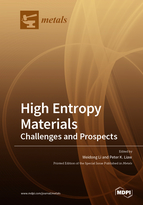High Entropy Materials: Challenges and Prospects
A special issue of Metals (ISSN 2075-4701).
Deadline for manuscript submissions: closed (31 December 2020) | Viewed by 36862
Special Issue Editors
Interests: mechanical behavior; fatigue and fracture behavior; nondestructive evaluation; neutron/synchrotron studies of advanced materials, including bulk metallic glasses; nanostructural materials; high-entropy alloys; superalloys; steels; intermetallics
Special Issues, Collections and Topics in MDPI journals
Interests: structural materials; metallic glasses; high-entropy alloys; solid mechanics
Special Issues, Collections and Topics in MDPI journals
Special Issue Information
Dear Colleagues,
As a family of newly-emerged structural materials, high-entropy alloys (or multicomponent alloys or compositionally complex alloys) are drawing extensive attention from materials scientists. These alloys are of great interest, firstly because they bring about the possibility of developing a greater amount of alloy species than ever before. Secondly, many extraordinary mechanical properties are being uncovered in these alloys, for example, excellent and easily tailorable strength, ductility, temperature tolerance, and fatigue and fracture resistance. From these perspectives, high-entropy alloys are very promising for next-generation structural materials. Therefore, in the past decade, world-wide efforts have been devoted to various aspects of high-entropy alloys, including synthesizing alloys with different microstructures and properties, appreciating their physical-metallurgy principles, and evaluating their mechanical properties such as creep, fracture and fatigue properties. Undoubtedly, these efforts have led to many major accomplishments. However, important challenges still exist. Examples include establishing sound metallurgy physics of high-entropy alloys, clarifying their deformation and strengthening mechanisms and understanding how and why they are distinct from conventional crystalline alloys, and making promising alloy systems practically applicable (for example, the density of refractory high-entropy alloys need to be reduced in order for their high-temperature applications as super alloys). As the research in high-entropy alloys moves on, researchers in this field should be well aware of the challenges and prospects ahead. This Special Issue intends to offer a dedicated platform for sharing new findings, communicating views about the past accomplishments and future directions in high-entropy alloy research. We welcome reviews and original research articles in the areas of physical metallurgy, microstructures, and mechanical properties of high-entropy alloys, achieved either by experimental techniques or theoretical calculations.
Prof. Peter K. Liaw
Dr. Weidong Li
Guest Editors
Manuscript Submission Information
Manuscripts should be submitted online at www.mdpi.com by registering and logging in to this website. Once you are registered, click here to go to the submission form. Manuscripts can be submitted until the deadline. All submissions that pass pre-check are peer-reviewed. Accepted papers will be published continuously in the journal (as soon as accepted) and will be listed together on the special issue website. Research articles, review articles as well as short communications are invited. For planned papers, a title and short abstract (about 100 words) can be sent to the Editorial Office for announcement on this website.
Submitted manuscripts should not have been published previously, nor be under consideration for publication elsewhere (except conference proceedings papers). All manuscripts are thoroughly refereed through a single-blind peer-review process. A guide for authors and other relevant information for submission of manuscripts is available on the Instructions for Authors page. Metals is an international peer-reviewed open access monthly journal published by MDPI.
Please visit the Instructions for Authors page before submitting a manuscript. The Article Processing Charge (APC) for publication in this open access journal is 2600 CHF (Swiss Francs). Submitted papers should be well formatted and use good English. Authors may use MDPI's English editing service prior to publication or during author revisions.
Keywords
- High-entropy alloys
- Physical metallurgy
- Microstructures
- Mechanical properties
- Theoretical calculations







